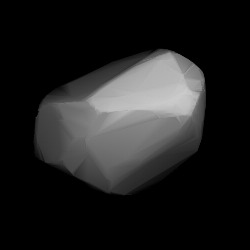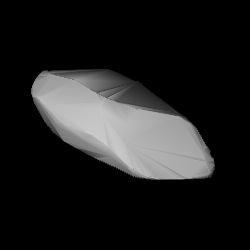Related Research Articles
3850 Peltier, provisional designation 1986 TK2, is a Florian asteroid and suspected interloper from the inner regions of the asteroid belt, approximately 4 kilometers in diameter. It was discovered on 7 October 1986, by American astronomer Edward Bowell at Lowell's Anderson Mesa Station, near Flagstaff, Arizona. The asteroid was named after American amateur astronomer Leslie Peltier.
795 Fini is a dark and large background asteroid, approximately 76 kilometers in diameter, located in the central region of the asteroid belt. It was discovered by Austrian astronomer Johann Palisa at the Vienna Observatory on 26 September 1914. The carbonaceous C-type asteroid has a poorly determined rotation period of 9.3 hours and seems rather spherical in shape. Any reference of the asteroid's name to a person is unknown.

920 Rogeria is a dark background asteroid from the central region of the asteroid belt, discovered by German astronomer Karl Reinmuth at the Heidelberg-Königstuhl State Observatory on 1 September 1919. The D-type asteroid (DT) has a rotation period of 12.2 hours and measures approximately 26 kilometers in diameter. It was named "Rogeria", a name unrelated to the discoverer's contemporaries, that was taken from the almanac Lahrer Hinkender Bote.
1065 Amundsenia, provisional designation 1926 PD, is a stony asteroid and sizeable Mars-crosser on an eccentric orbit from the inner asteroid belt, approximately 10 kilometers in diameter. It was discovered on 4 August 1926, by Soviet astronomer Sergey Belyavsky at the Simeiz Observatory on the Crimean peninsula. The asteroid was named after Norwegian polar explorer Roald Amundsen.

1088 Mitaka is a bright background asteroid from the inner regions of the asteroid belt. It was discovered on 17 November 1927, by Japanese astronomer Okuro Oikawa at the old Tokyo Astronomical Observatory in Japan. The stony S-type asteroid has a notably short rotation period of 3.0 hours and measures approximately 15 kilometers in diameter. It was named after the Japanese village of Mitaka.
(9992) 1997 TG19 is a stony asteroid and eccentric Mars-crosser, approximately 4 kilometers in diameter. It was discovered on 8 October 1997, by Japanese astronomers Tetsuo Kagawa and Takeshi Urata at Gekko Observatory near Shizuoka, Japan.
4899 Candace, provisional designation 1988 JU, is a background asteroid from the inner regions of the asteroid belt, approximately 7 kilometers in diameter. It was discovered on 9 May 1988, by astronomer couple Carolyn and Eugene Shoemaker at the Palomar Observatory in California, United States. The asteroid was named after American chemist Candace Kohl.
39890 Bobstephens, provisional designation 1998 FA3, is a stony asteroid from the middle region of the asteroid belt, approximately 2 kilometers in diameter. The asteroid was discovered on 23 March 1998, by Czech astronomer Petr Pravec at Ondřejov Observatory near Prague in the Czech Republic. It was named for American astronomer Robert Stephens.
4029 Bridges, provisional designation 1982 KC1, is a stony asteroid and binary system from the middle regions of the asteroid belt, approximately 8 kilometers in diameter.
4008 Corbin, provisional designation 1977 BY, is a stony Phocaea asteroid from the inner regions of the asteroid belt, approximately 6 kilometers in diameter. It was discovered on 22 January 1977, by staff members of the Felix Aguilar Observatory's at the Leoncito Astronomical Complex in Argentina.
1806 Derice, provisional designation 1971 LC, is a stony Flora asteroid from the inner regions of the asteroid belt, approximately 10 kilometers in diameter. Discovered on 13 June 1971, at the Bickley site of the Perth Observatory in Western Australia, it was the first discovery of a minor planet ever made in Oceania. The asteroid was named after the wife of Dennis Harwood, staff member at Bickley.

1338 Duponta, provisional designation 1934 XA, is a stony Florian asteroid and synchronous binary system from the inner regions of the asteroid belt, approximately 7.8 kilometers in diameter.
1736 Floirac, provisional designation 1967 RA, is a stony Florian asteroid from the inner regions of the asteroid belt, approximately 8.7 kilometer in diameter.
19763 Klimesh, provisional designation 2000 MC, is a stony Phocaea asteroid and slow rotator from the inner regions of the asteroid belt, approximately 7 kilometers in diameter. Discovered by NEAT at Haleakala Observatory in 2000, the asteroid was named for NEAT's software specialist Matthew Klimesh.

1559 Kustaanheimo, provisional designation 1942 BF, is a stony asteroid from the inner regions of the asteroid belt, approximately 11 kilometers in diameter. It was discovered on 20 January 1942, by Finnish astronomer Liisi Oterma at the Iso-Heikkilä Observatory near Turku in southwest Finland. The asteroid was named after Finnish astronomer Paul Kustaanheimo (1924–1997).

2094 Magnitka (prov. designation: 1971 TC2) is a Flora asteroid from the inner regions of the asteroid belt, approximately 12 kilometers (7.5 miles) in diameter. It was discovered on 12 October 1971, at and by the Crimean Astrophysical Observatory in Nauchnyj, on the Crimean peninsula. The discovery has not been attributed to an observing astronomer. It was later named for the city of Magnitogorsk.
4082 Swann, provisional designation 1984 SW3, is a carbonaceous asteroid from the inner regions of the asteroid belt, approximately 10 kilometers in diameter.
3401 Vanphilos, provisional designation 1981 PA, is a stony, eccentric asteroid and sizeable Mars-crosser, approximately 7 kilometers in diameter. It was discovered on 1 August 1981, by and at Harvard's Oak Ridge Observatory in Massachusetts, United States.
2862 Vavilov, provisional designation 1977 JP, is a stony background asteroid and exceptionally slow rotator from the inner regions of the asteroid belt, approximately 7 kilometers in diameter. It was discovered on 15 May 1977, by Soviet astronomer Nikolai Chernykh at the Crimean Astrophysical Observatory in Nauchnij, on the Crimean peninsula. The asteroid was named after Russian plant geneticist Nikolai Vavilov and his physicist brother Sergey Ivanovich Vavilov.
1530 Rantaseppä, provisional designation 1938 SG, is a stony Florian asteroid from the inner regions of the asteroid belt, approximately 5 kilometers in diameter. Discovered by Yrjö Väisälä at Turku Observatory in 1938, it was later named after Finnish astronomer Hilkka Rantaseppä-Helenius.
References
- 1 2 3 4 5 6 "JPL Small-Body Database Browser: 1293 Sonja (1933 SO)" (2017-02-15 last obs.). Jet Propulsion Laboratory . Retrieved 26 July 2017.
- 1 2 3 Schmadel, Lutz D. (2007). "(1293) Sonja". Dictionary of Minor Planet Names – (1293) Sonja. Springer Berlin Heidelberg. p. 106. doi:10.1007/978-3-540-29925-7_1294. ISBN 978-3-540-00238-3.
- 1 2 3 "1293 Sonja (1933 SO)". Minor Planet Center. Retrieved 18 January 2017.
- 1 2 3 4 5 6 "LCDB Data for (1293) Sonja". Asteroid Lightcurve Database (LCDB). Retrieved 18 January 2017.
- 1 2 3 4 Usui, Fumihiko; Kuroda, Daisuke; Müller, Thomas G.; Hasegawa, Sunao; Ishiguro, Masateru; Ootsubo, Takafumi; et al. (October 2011). "Asteroid Catalog Using Akari: AKARI/IRC Mid-Infrared Asteroid Survey". Publications of the Astronomical Society of Japan. 63 (5): 1117–1138. Bibcode:2011PASJ...63.1117U. doi: 10.1093/pasj/63.5.1117 . (online, AcuA catalog p. 153)
- 1 2 3 4 Tedesco, E. F.; Noah, P. V.; Noah, M.; Price, S. D. (October 2004). "IRAS Minor Planet Survey V6.0". NASA Planetary Data System. 12: IRAS-A-FPA-3-RDR-IMPS-V6.0. Bibcode:2004PDSS...12.....T . Retrieved 22 October 2019.
- 1 2 Higgins, David; Goncalves, Rui M. D. (March 2007). "Asteroid Lightcurve Analysis at Hunters Hill Observatory and Collaborating Stations - June-September 2006". The Minor Planet Bulletin. 34 (1): 16–18. Bibcode:2007MPBu...34...16H. ISSN 1052-8091 . Retrieved 18 January 2017.
- 1 2 Behrend, Raoul. "Asteroids and comets rotation curves – (1293) Sonja". Geneva Observatory . Retrieved 18 January 2017.
- 1 2 Benishek, Vladimir (March 2008). "CCD Photometry of Seven Asteroids at the Belgrade Astronomical Observatory". The Minor Planet Bulletin. 35 (1): 28–30. Bibcode:2008MPBu...35...28B. ISSN 1052-8091 . Retrieved 18 January 2017.
- ↑ Veres, Peter; Jedicke, Robert; Fitzsimmons, Alan; Denneau, Larry; Granvik, Mikael; Bolin, Bryce; et al. (November 2015). "Absolute magnitudes and slope parameters for 250,000 asteroids observed by Pan-STARRS PS1 - Preliminary results". Icarus. 261: 34–47. arXiv: 1506.00762 . Bibcode:2015Icar..261...34V. doi:10.1016/j.icarus.2015.08.007 . Retrieved 18 January 2017.
- ↑ Schmadel, Lutz D. (2007). "(579) Sidonia". Dictionary of Minor Planet Names – (579) Sidonia / ARI note from 1913. Springer Berlin Heidelberg. pp. 59–60. doi:10.1007/978-3-540-29925-7_580. ISBN 978-3-540-00238-3.
- ↑ Schmadel, Lutz D. (2007). "Appendix 11 – Minor Planet Names with Unknown Meaning". Dictionary of Minor Planet Names – Fifth Revised and Enlarged revision. Springer Berlin Heidelberg. pp. 927–929. ISBN 978-3-540-00238-3.